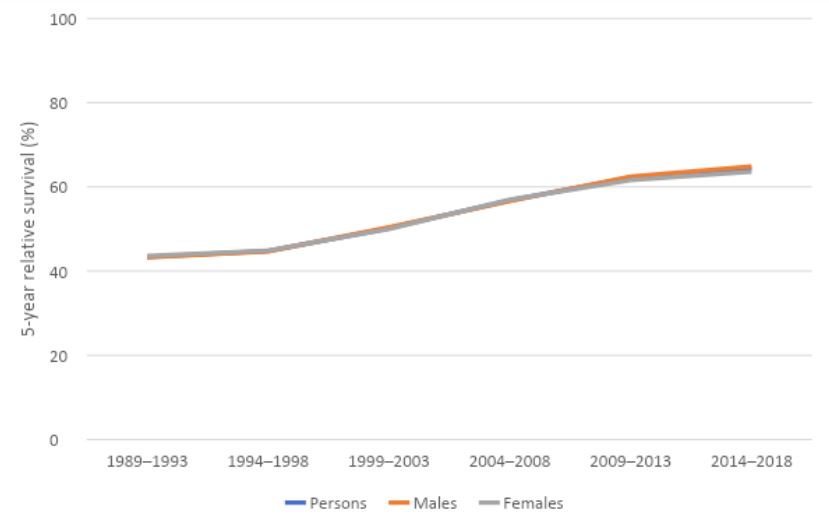The following material has been sourced from the Australian Institute of Health and Welfare
Leukaemia incorporates ICD-10 cancer codes C91 (lymphoid leukaemia), C92 (myeloid leukaemia), C93 (monocytic leukaemia), C94 (other leukaemias of specified cell type) and C95 (leukaemias of unspecified cell type).
Estimated number of new cases of leukaemia diagnosed in 2022
5,202 =  3,198 males +
3,198 males +  2,004 females
2,004 females
Estimated % of all new cancer cases diagnosed in 2022
3.2%
Estimated number of deaths from leukaemia in 2022
2,121 =  1,317 males +
1,317 males +  804 females
804 females
Estimated % of all deaths from cancer in 2022
4.2%
Chance of surviving at least 5 years (2014–2018)
64%
People living with leukaemia at the end of 2017 (diagnosed in the 5 year period 2013 to 2017)
14,094
New cases
In 2018, there were 4,516 new cases of leukaemia diagnosed in Australia (2,740 males and 1,776 females). In 2022, it is estimated that 5,202 new cases of leukaemia will be diagnosed in Australia (3,198 males and 2,004 females). In 2022, it is estimated that a person has a 1 in 58 (or 1.7%) risk of being diagnosed with leukaemia by the age of 85 (1 in 47 or 2.1% for males and 1 in 77 or 1.3% for females).

Figure 1. Estimated cancer incidence in Australia, 2022
Notes
- Data sourced from AIHW Cancer Data in Australia 2022 web report and supplementary data tables
- More information about incidence rates for the most common cancers diagnosed can be found on the NCCI website in the ‘Cancer incidence’ section (https://ncci.canceraustralia.gov.au/diagnosis/cancer-incidence/cancer-incidence)
In 2018, the age-standardised incidence rate was 16 cases per 100,000 persons (20 for males and 12 for females). In 2022, it is estimated that the age-standardised incidence rate will remain at 16 cases per 100,000 persons (21 for males and 12 for females). The incidence rate for leukaemia is expected to increase with age, highest for those aged 85–89 years.

Figure 2. Age-standardised incidence rates for leukaemia, 1982 to 2018, by sex
Notes:
- Data sourced from AIHW Cancer Data in Australia 2022 web report and supplementary data tables
- More information about incidence rates for leukaemia over time, by age, sex, Indigenous status, remoteness, and socioeconomic status (SES) can be found on the NCCI website in the ‘Cancer incidence’ section (https://ncci.canceraustralia.gov.au/diagnosis/cancer-incidence/cancer-incidence)
The number of new cases of leukaemia diagnosed increased from 1,645 (948 males and 697 females) in 1982 to 4,516 in 2018. Over the same period, the age-standardised incidence rate increased from 13 cases per 100,000 persons (17 for males and 10 for females) in 1982 to 16 cases per 100,000 in 2018.
Deaths
In 2020, there were 1,959 deaths from leukaemia in Australia (1,203 males and 756 females). In 2022, it is estimated that there will be 2,121 deaths (1,317 males and 804 females). In 2022, it is estimated that a person has a 1 in 154 (or 0.65%) risk of dying from leukaemia by the age of 85 (1 in 120 or 0.83% for males and 1 in 217 or 0.46% for females).

Figure 3. Estimated cancer mortality in Australia, 2022
Notes
- Data sourced from AIHW Cancer Data in Australia 2022 web report and supplementary data tables
- More information about mortality rates for the most common causes of cancer death can be found on the NCCI website in the ‘Cancer mortality’ section (https://ncci.canceraustralia.gov.au/outcomes/cancer-mortality/cancer-mortality)
In 2020, the age-standardised mortality rate was 6.0 deaths per 100,000 persons (8.1 for males and 4.2 for females). In 2022, it is estimated that the age-standardised mortality rate will be 6.1 deaths per 100,000 persons (8.4 for males and 4.2 for females). The mortality rate for leukaemia is expected to increase with age.

Figure 4. Age-standardised mortality rates for leukaemia, 1982 to 2020, by sex
Notes:
- Data sourced from AIHW Cancer Data in Australia 2022 web report and supplementary data tables
- More information about mortality rates for the most common causes of cancer death can be found on the NCCI website in the ‘Cancer mortality’ section (https://ncci.canceraustralia.gov.au/outcomes/cancer-mortality/cancer-mortality)
The number of deaths from leukaemia increased from 966 (529 males and 437 females) in 1982 to 1,959 in 2020. Over the same period, the age-standardised mortality rate remained similar from 8.0 deaths per 100,000 persons (10 for males and 6.5 for females) in 1982 to 6 deaths per 100,000 in 2020.
Survival
In 2014–2018, individuals diagnosed with leukaemia had a 64% chance (65% for males and 64% for females) of surviving for five years compared to their counterparts in the general Australian population. Between 1989–1993 and 2014–2018, five-year relative survival for leukaemia improved from 43% to 64%.

Figure 5. 5-year relative survival for leukaemia, 1989–1993 to 2014–2018, by sex
Notes:
- Data sourced from AIHW Cancer Data in Australia 2022 web report and supplementary data tables
- More information about mortality rates for the most common causes of cancer death can be found on the NCCI website in the ‘Cancer mortality’ section (https://ncci.canceraustralia.gov.au/outcomes/cancer-mortality/cancer-mortality)
Prevalence
At the end of 2017, there were 3,705 people living who had been diagnosed with leukaemia that year, 14,094 people living who had been diagnosed with leukaemia in the previous 5 years (from 2013 to 2017) and 35,443 people living who had been diagnosed with leukaemia in the previous 36 years (from 1982 to 2017).
For more information see Leukaemia on the NCCI website
The National Cancer Control Indicators (NCCI) are a set of indicators across the continuum of cancer care, from Prevention and Screening through to Diagnosis, Treatment, Psychosocial care, Research and Outcomes. The NCCI website allows users to see visual representations of data on each indicator through interactive charts.




